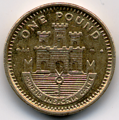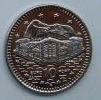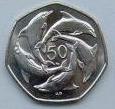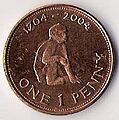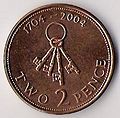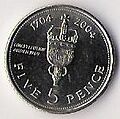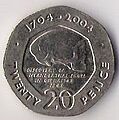Gibraltar pound facts for kids
Quick facts for kids Gibraltar pound |
|
|---|---|
| ISO 4217 Code | GIP |
| Official user(s) | |
| Unofficial user(s) | |
| Inflation | 2.0% (2013 est.) |
| Source | [1] |
| Pegged with | sterling at par |
| Subunit | |
| 1⁄100 | Penny |
| Symbol | £ |
| Penny | p |
| Plural | Pounds |
| Penny | Pence |
| Coins | 1p, 2p, 5p, 10p, 20p, 50p, £1, £2, £5 |
| Banknotes | |
| Freq. used | £5, £10, £20, £50 |
| Rarely used | £100 |
The Gibraltar pound (symbol: £; ISO code: GIP) is the money used in Gibraltar. It is directly linked to the British pound sterling. This means one Gibraltar pound is always worth the same as one British pound. The Government of Gibraltar prints its own coins and banknotes.
Contents
History of Gibraltar's Money
For a long time, Gibraltar used a mix of different currencies. Before 1872, people used British, Spanish, and local Gibraltar coins. The main local coin was called the Gibraltar real.
In 1872, only Spanish money became the official currency. But in 1898, after the Spanish–American War, the value of the Spanish money dropped a lot. Because of this, the British pound became the only official money in Gibraltar. At first, they used British coins and banknotes.
Since 1927, Gibraltar has printed its own banknotes. They started making their own coins in 1988. In 1971, Gibraltar changed its money system to a decimal system, just like the UK. This meant 1 pound was now equal to 100 pence, instead of the old system where 1 pound was 240 pence.
How Gibraltar's Pound Connects to the British Pound
The Government of Gibraltar has the right to print its own money. This money is called "pounds sterling" on the notes. However, these Gibraltar notes are not official money in the United Kingdom. This means you cannot use them to buy things in the UK.
Gibraltar's coins are the same size, weight, and metal as British coins. But their designs are different. Sometimes, you might find Gibraltar coins being used in Britain.
Both Gibraltar coins and British coins are official money in Gibraltar. People in Gibraltar accept both types of money, and they are worth the same.
Gibraltar's Coins
Since 1988, Gibraltar has made its own coins. These coins have special designs and say "Gibraltar" on them. They come in values of 1, 2, 5, 10, 20, and 50 pence, and 1 pound. In 1999, 2-pound coins were added. A 5-pound coin was made in 2010. This coin had the words "Elizabeth II · Queen of Gibraltar" on it.
The 2-pound coin has a new design each year. It shows one of the 12 Labours of Hercules.
Special Coin Editions
In 2004, Gibraltar made special coins to celebrate 300 years of British Gibraltar (1704–2004). These coins had unique designs to mark the event.
In 2005, another new set of coins was released. These coins used some of the designs from the 2004 special edition. A 5-pound coin was part of this series, showing the famous Rock of Gibraltar.
Gibraltar's Banknotes
During the First World War, Gibraltar started printing its own banknotes. This was to avoid using up British money or gold. The first notes were signed by hand. Later, new notes were introduced in 1927.
Over the years, new banknote values were added. In 1975, £10 and £20 notes were introduced. A £50 note followed in 1986. The £1 note stopped being used in 1988.
In 1995, a new series of notes was printed. For the first time, these notes clearly said "pounds sterling." In 2010 and 2011, more new notes were issued, including £5, £10, £20, £50, and £100.
In 2021, Gibraltar began issuing a new series of banknotes. These notes are smaller, similar in size to the banknotes used in the Bank of England. The first of these new notes was the £5 note.
| Gibraltar Banknotes (2010-2011 Series) | ||||||
|---|---|---|---|---|---|---|
| Image | Value | Size | Main Color | What it Shows | ||
| Front | Back | Front | Back | |||
| £5 | 133 × 70 mm | Green | Queen Elizabeth II, Gibraltar's Coat of Arms |
Upper Ward and Tower of Homage of the Moorish castle | ||
| £10 | 141 × 75 mm | Blue | Queen Elizabeth II, Gibraltar's Coat of Arms |
Artist John Trumbull’s painting “The Sortie Made by the Garrison of Gibraltar” showing a battle during the Great Siege of Gibraltar (1779–83) | ||
| £20 | 150 × 80 mm | Orange | Queen Elizabeth II, Gibraltar's Coat of Arms |
HMS Victory being pulled back to Gibraltar after the Battle of Trafalgar | ||
| £50 | 157 × 85 mm | Red | Queen Elizabeth II, Gibraltar's Coat of Arms |
Casemates Square buildings | ||
| £100 | 164 × 90 mm | Purple | Queen Elizabeth II, Gibraltar's Coat of Arms |
King's Bastion | ||
| Gibraltar Banknotes (2021 Series) | ||||||
|---|---|---|---|---|---|---|
| Image | Value | Size | Main Color | What it Shows | ||
| Front | Back | Front | Back | |||
| £5 | 125 × 65 mm | Green | Queen Elizabeth II, Gibraltar's Coat of Arms |
Windsor Bridge | ||
| Current GIP exchange rates | |
|---|---|
| From Google Finance: | AUD CAD CHF EUR GBP HKD JPY USD GBP JPY USD |
| From Yahoo! Finance: | AUD CAD CHF EUR GBP HKD JPY USD GBP JPY USD |
| From XE.com: | AUD CAD CHF EUR GBP HKD JPY USD GBP JPY USD |
| From OANDA: | AUD CAD CHF EUR GBP HKD JPY USD GBP JPY USD |
| From fxtop.com: | AUD CAD CHF EUR GBP HKD JPY USD GBP JPY USD |
Images for kids
See also
- Economy of Gibraltar
- Currency board
- Christopher Ironside, OBE, coin designer: reverse design of the 25 New Pence coin, Barbary ape (issued 1971).



